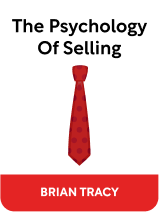

This article is an excerpt from the Shortform book guide to "The Psychology Of Selling" by Brian Tracy. Shortform has the world's best summaries and analyses of books you should be reading.
Like this article? Sign up for a free trial here .
What are the six kinds of customers? What are their key characteristics?
According to Brian Tracy, the author of The Psychology of Selling, there are six types of customers every salesperson should know about: 1) the reluctant customer, 2) the certain customer, 3) the analytical customer, 4) the relationship customer, 5) the directive customer, and 6) the social customer. To consistently close sales, you have to know how to tailor your sales pitch to each of these six types.
In this article, we’ll take a look at the characteristics of each of the six types of customer and how can adjust your pitch to each.
The 6 Kinds of Customer
Everyone responds differently to information and questions, and if you can figure out how to best engage each of the six kinds of customers, answering their particular needs, you’ll have a much higher success rate.
There are six common kinds of customers, with an approximate percentage of the buyers in each category. (You’ll note these numbers don’t add up to 100 percent, but keep in mind these are approximate numbers just to give you a rough idea):
- The Reluctant Customer: About 5 percent of customers are suspicious, cynical, and chronically uninterested. This type of buyer will generally focus on the aspect of a pitch that she finds negative and will never move off of that topic; she’s unlikely to ever say “yes” to a proposal, so don’t spend a lot of time with her. Extricate yourself as politely as you can, and look for someone else more open to your message.
- The Certain Customer: About 5 percent of your buyers will be the exact opposite of the reluctant buyer: They’ll know exactly what features and benefits they need and what price they’re prepared to pay. When meeting with a certain customer, sell her exactly what she’s looking for—if you try to oversell her when she’s not interested, she’s going to be put off, and you may lose the sale entirely. You can give her additional information, but expect her to know her limits and stick to them.
- The Analytical Customer: About 25 percent of your buyers will fall into this category. These buyers move slowly to be sure they make the right decision. They love details and want you to prove everything you claim on paper. Don’t rush this buyer. Be methodical, go over details thoroughly, and take time to fully answer each question.
- The Relationship Customer: Another 25 percent of your buyers will prioritize being liked and getting along with people. This type of buyer wants to build a relationship with you before committing to a purchase. She needs time to make a decision and values the opinions of others highly when evaluating products or services. When dealing with a relationship customer, slow down and ask a lot of questions. Talk about other customers who have been happy with your products or services. You may need more than one meeting to close the sale.
- The Directive Customer: Another 25 percent of your buyers will be directive customers, who are task-oriented. This buyer is busy, businesslike, and practical. She is laser-focused on the benefits your product can provide and doesn’t care about building a warm relationship with you personally. When dealing with a directive customer, don’t bother with small talk, and don’t go into details on background information, like how your product was developed. Focus on the bottom line: exactly how your product can help her. Get right to the point so she doesn’t feel you’re wasting her time.
- The Social Customer: About 25 percent of your customers will be social customers, who are gregarious and extroverted. You’ll often find this type of buyer in fields that involve a high degree of integration between teams of people—supervisors, project managers, orchestra conductors, and senior executives of large firms. When dealing with a social buyer, expect her to be talkative and friendly, and be positive and open in return. If she agrees to a purchase, be sure to get it in writing immediately—this type of buyer is prone to forgetting commitments soon after she makes them.
You may benefit from having several versions of your presentation that you’ve practiced and can switch into at the drop of a hat, so that when you detect you’re dealing with a certain type of buyer, you can immediately pivot to using a presentation suited to their personality style.

———End of Preview———
Like what you just read? Read the rest of the world's best book summary and analysis of Brian Tracy's "The Psychology Of Selling" at Shortform .
Here's what you'll find in our full The Psychology Of Selling summary :
- How to dramatically increase your sales
- How to know what your customers are thinking
- Brian Tracy's 10 guidelines for success






